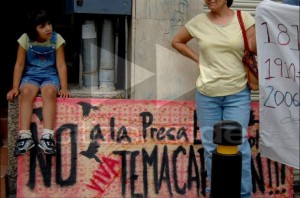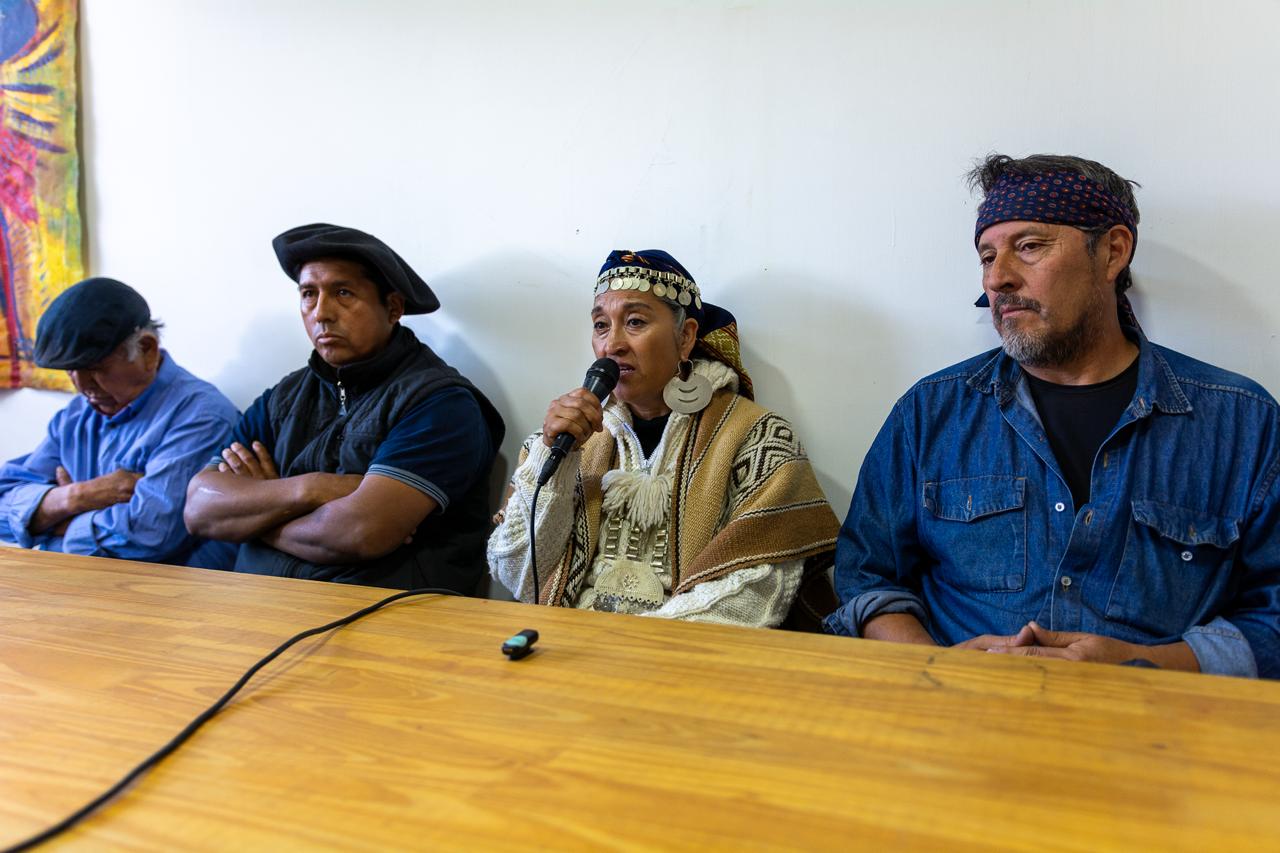 “The eyes of the world are on Temacapulin.”
“The eyes of the world are on Temacapulin.”
So declared an anti-dam banner wrapped around a gazebo in the tiny Mexican village. Alongside it, banners named the Mekong River and the Naradama Valley. Solidarity is probably the single best hope for the 500 residents of this town on the brink of being submerged.
It’s a battle of David and Goliath proportions. Father Gabriel, the local priest, tweaked the final words of the Lord’s Prayer, urging, “Lead us not into temptation and deliver us from dams. Amen.”
Rivers for Life 3, an international movement of dam critics and river protectors, gathered in Temacapulin this year. Representatives from dam-affected communities all over the world flew in to participate, from the Thai-Burmese border, Kenya, and China – 62 countries in all.
Managing our water commons thoughtfully in an age of growing energy demand and climate change is a considerable challenge, especially when the World Bank ignores its own advice to wean ourselves off large dams. That study by the World Commission on Dams finds large dams inconsistent with environmental and human rights standards. A global movement, including activists from Our Water Commons, continues to press to rein in the dam industry, invest in truly green solutions and apply common sense principles for how we manage our water.
And so, on the fourth day, hundreds of people – townsfolk and national and international activists – marched down hot and dusty switchbacks, past bulldozers, deeper and deeper into a narrowing canyon to the spot where a dam called El Zapotillo is slated to block the flow of the Rio Verde with a mammoth cement wall.
In spite of the rousing chants – “El pueblo unido jamas sera vencido (the people united will never be defeated)”, and vigorously waved flags and banners from some of the 62 countries represented at the forum – I imagine others shared my feeling of dread when we saw the massive chutes that will channel water into hydroelectric turbines. The model homes for relocation village are already partially built, standing empty. Can defense of the commons prevail in the face of this giant investment?
Everyone agreed with Father Gabriel that the march to the dam must be non-violent. Yet some seemed unable to stop themselves from giving a swift kick to a construction cone. The previous day, frustrated and increasingly desperate leaders nearly succeeded in getting forum participants to put aside the agenda and occupy the site.
“I just wish that instead of ignoring us, the politicians and water commission would come here and tell us to our face: You know why we can do this to you? Because you’re stinking peasants and you’re not worth shit,” said a Temacapulin resident.
“Get out of your hammocks,” town leaders exhorted their less active neighbors. “The time is now.” “Shhhh,” whispered a light-skinned woman in a beehive hairdo who I can only guess wasn’t an activist until the dam loomed. “We know there are spies here.” “Let them hear us,” others answered. “Let them see that we won’t stop until they stop building the dam.” A lawyer from Amnesty International gathered testimony to build an international human rights case.
Father Gabriel said, “We may be a small town, but our dignity is large.”
Putting aside a spontaneous march for more deliberate action, the community sat together for an entire day to ensure that any action taken might be part of a longer-term strategy. The day’s symbolic act was meant as a healing caress to the scarred canyon walls and strangled river and to buoy the energy and commitment of the townspeople who will have to hold the line after the solidarity activists return home.
Temacapulin Fights for Survival
Temacapulin’s cobblestone streets are lined with whitewashed adobe houses, a stunning rose-rock 18th century church, and neighbors chatting from their stoops and doorways. You can’t help but take a deep breath and let time and worries go – even though that peacefulness is splintered by the sound of earth-moving machinery. Christ’s image is etched into a cliff (sadly I couldn’t make it out, which apparently is an unlucky portent) and more than 20 hot springs percolate up through the earth, creating a local tourist attraction.
Among the mostly farming families, wrongheaded national and international agriculture and trade policies have fed a wave of migration from the Temacapulin area to the United States and Guadalajara. Many at the gathering describe these as intentional expulsion policies – with no humans around to protest, it’s easier for the government and transnational firms to pillage and appropriate the natural abundance. A resident asked rhetorically, “Why don’t they provide us with the tools, credit and agronomists we need to work our land and live well instead of flooding us out?”
Temacapulin’s demography now spikes toward the elderly, many of whom couldn’t participate in the march to the dam site. Youth, however, have resurfaced in a spirited diaspora network of “absent sons and daughters.” They have been summoned to come home and fight, and form natural links to the international movement.
Over 47,000 large dams around the world have displaced some 40,000,000 people. The World Bank has invested more than $60 billion in 600 dams. The environmental movement has put a brake on large dams in the U.S.–it has already succeeded in dismantling some. But it hasn’t been able to diminish the U.S. appetite for energy. Many Mexican hydroelectric dams principal purpose is to export energy north through inter-connected grids to air-conditioned cities such as Phoenix and Las Vegas. Under NAFTA, Mexican electricity is welcome even as the U.S. militarizes a border fence.
I had the pleasure of exploring Temacapulin’s nooks with one of the town’s characters. At 77, Don Poncho still scampers up the hillside like a mountain goat, with a gaggle of us panting behind. At the top is the tomb of his great grandmother in an 1860’s Juarez-era cemetery. Back in his cornfield, he machetied back brush to uncover a boulder carved with pre-Hispanic spirals. In the shadows of cliffs, among giant ferns and cactus, a waterfall spitting, we counted over 40 species of butterflies. Reflecting on the visit to the dam at an evening meeting, Don Poncho’s voice trembled, “I’ll defend this valley, my cornfield, my ancestors. The only thing I have to lose is my life. Nothing more.”
Stopping the Dam
The international meeting sparked a heated debate on how to get this mega-project permanently shelved. Many proposed persevering through legal measures. The problem is that Mexico’s legal system is notoriously corrupt and faulty. One judge’s order to suspend dam construction has been ignored.
Mexican university professor Octavio Rosa Landis, affiliated with the Mexican Center for Social Analysis, Information, and Training (CASIFOP) lamented how successful Mexico’s PR machine has been. Internationally, the image of a budding Mexican democracy remains robust despite the tens of thousands of assassinations and detentions ascribed to the drug war.
The offensive against the narcos is painted as a defense of Mexican democracy. The U.S. government has poured more than a billion dollars into this militarization model and routinely touts the virtues of free trade with its neighbor while ignoring human rights violations and the inequities caused by NAFTA. The U.S. government has considerable self-interest in portraying Mexico as a success story. We hear less about how the drug war serves as a cover for government-sponsored thugs to knock off opposition leaders. Booting the PRI party from 70 years of presidential power in 2000 was supposed to change things. But in 2006 the right-wing PAN party committed electoral fraud to gain the presidency. With poverty, human rights abuses and pillage of the commons on the rise, political opposition is considerable and repression is fierce.
Activists who stood on cranes and excavators at the dam site were happy to hear a federal congressional representative promise to push his colleagues to enforce the court order suspending construction. An angry crowd swarmed around a construction supervisor and pressed him to cough up the names of his supervisors. Under questioning, he admitted he’d be doing what they were doing if his village was about to be flooded. But still, he couldn’t remember his superiors’ names.
He sweated under his hard hat when half a dozen people taunted, “estas chingando la nacion (you’re f***ing the nation).” In a tense moment, the crowd’s attention turned to boulders tumbling down the canyon’s edge, apparently from a work camp above. Intentional or not, the landslides pose a considerable threat. In one large dam in China, boulders plunging down a denuded rock face produced a giant wave that forced the evacuation of 70,000 people downstream. Father Gabriel asked for calm and reiterated the commitment to non-violence.
Going forward, Temacapulin residents hope to set up a watchdog camp to monitor the construction. Citizen groups in Leon and Guanajuato will pressure their officials not to buy water coming from the dam. International supporters will help by demanding that development banks withdraw financing.
Despite the obstacles, the gathering showed great enthusiasm, creativity and commitment. The only pall was the morning fog that burned off by ten. On two evenings, the town square boomed with world music. The Africans had the whole town spinning and bouncing, the Tajiks and Chinese sang songs that sounded plaintive but were apparently happy and South Asians moved their necks in cobra-like dance. When the MC tried to wind things down around midnight, a knot of local teenage girls chanted, “We’re not tired, we’re not tired.” Many of us straggled from the party to take a late night soak in the hot springs.
The town transformed for the week as 500 delegates slept in people’s homes, many adorned with signs that said, “Not for sale, we’re not moving.” A sense of genuine solidarity, based on the beginnings of friendship, was born. In an outdoor kitchen erected in the church courtyard, colossal pots of beans bubbled and mountains of local corn boiled. We washed our dishes in vats of water next to a bicycle-powered blender in front of a compost pile the size of a human grave.
Tents set up in the church plaza, the soccer field, the school, a dead end street and other public places hosted the work sessions. Workshops described the environmental ravages of dams, their poor efficiency and their contribution to climate change; others explored organizing tactics such as local and national referendums, connecting upstream and downstream communities in watershed councils and promoting alternative sources of energy. An Australian group formed to save the Mary River described how they had legally mandated citizen oversight of new sustainable water management practices, included blocking a proposed dam. An economist from Mozambique described his organization’s research that proved that Mozambique didn’t need a proposed dam and demand could be satisified by tightening up inefficiencies in the grid and among heavy consumers.
Governments and lenders promote capital-intensive hydroelectric megaprojects as symbols of modernization and because they produce huge contracts for private businesses, but the Mozambique study and others show that decentralized biomass, solar and smaller dams can better and more sustainably satisfy energy and water needs. When the Mozambique group made this claim publicly, its website was blocked and the speaker had to start watching his back. Burmese, Colombian, Ethiopian, Chinese and Mexican activists have been killed for their environmental and human rights work. Still, these threats haven’t succeeded in holding back a wave of activism to manage water as a commons, safeguarding its health for future generations.
We gathered in church plaza for a final picture, an aerial shot snapped from the roof of the church. Visitors and townspeople crowded around a multicolored sawdust mural the size of a basketball court that read – Rivers for Life, not for Death.
After the picture, Marcos took the megaphone, a Mexican organizer from the Mexican Network Against Dams. He led us in a blessing of the four directions, the sky and then the earth. He asked us to try to block out the sound of the bulldozers and listen for the sound of the river that they seek to drown out.
It sounds hokey, but when I let go of my skepticism and closed my eyes, I swear I could feel a current tugging at my ankles, the rivers from the Catskills to El Salvador to the Sierras, all that water that has carried me along. Even hokier, I swallowed back tears.
An activist from India got it right. Cutting through the week’s heady political and economic analysis, he said simply, “Unless all of us – so connected to water already – can reconnect to that water, we’ll never succeed in managing it sensibly.”
I can drink to that.
Editor: Laura Carlsen
ufeff



